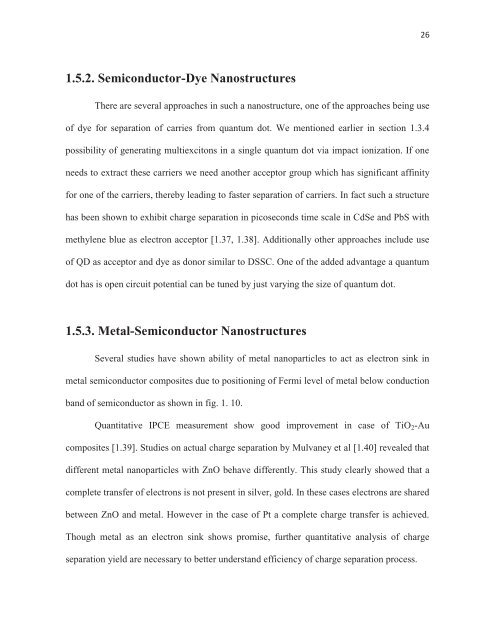CHEM01200604009 Sreejith Kaniyankandy - Homi Bhabha ...
CHEM01200604009 Sreejith Kaniyankandy - Homi Bhabha ...
CHEM01200604009 Sreejith Kaniyankandy - Homi Bhabha ...
Create successful ePaper yourself
Turn your PDF publications into a flip-book with our unique Google optimized e-Paper software.
26<br />
1.5.2. Semiconductor-Dye Nanostructures<br />
There are several approaches in such a nanostructure, one of the approaches being use<br />
of dye for separation of carries from quantum dot. We mentioned earlier in section 1.3.4<br />
possibility of generating multiexcitons in a single quantum dot via impact ionization. If one<br />
needs to extract these carriers we need another acceptor group which has significant affinity<br />
for one of the carriers, thereby leading to faster separation of carriers. In fact such a structure<br />
has been shown to exhibit charge separation in picoseconds time scale in CdSe and PbS with<br />
methylene blue as electron acceptor [1.37, 1.38]. Additionally other approaches include use<br />
of QD as acceptor and dye as donor similar to DSSC. One of the added advantage a quantum<br />
dot has is open circuit potential can be tuned by just varying the size of quantum dot.<br />
1.5.3. Metal-Semiconductor Nanostructures<br />
Several studies have shown ability of metal nanoparticles to act as electron sink in<br />
metal semiconductor composites due to positioning of Fermi level of metal below conduction<br />
band of semiconductor as shown in fig. 1. 10.<br />
Quantitative IPCE measurement show good improvement in case of TiO 2 -Au<br />
composites [1.39]. Studies on actual charge separation by Mulvaney et al [1.40] revealed that<br />
different metal nanoparticles with ZnO behave differently. This study clearly showed that a<br />
complete transfer of electrons is not present in silver, gold. In these cases electrons are shared<br />
between ZnO and metal. However in the case of Pt a complete charge transfer is achieved.<br />
Though metal as an electron sink shows promise, further quantitative analysis of charge<br />
separation yield are necessary to better understand efficiency of charge separation process.
















